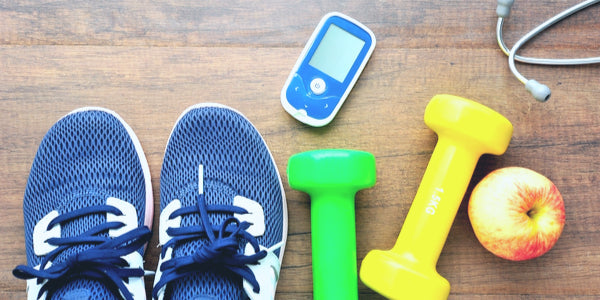
Diabetes is when the body is unable to utilize glucose from carb sources. This is mostly related to the absence or resistance of insulin.
There are two types of diabetes, including types 1 and 2 diabetes. Type 1 diabetes is when the body's own immune system destroys the cells that produce insulin. Blood sugars rise mostly related to insulin resistance in type 2 diabetes.
Without proper management, high blood sugars increase the risk of diabetes complications, including high blood pressure and nerve damage. But if diagnosed with diabetes, adopting a healthy lifestyle routine can improve blood sugars and overall health!
Core components of a diabetes routine include checking your blood sugar, eating a balanced diet, and exercising regularly. One might also be prescribed to diabetes medication.
Though living with and developing diabetes does require care and attention, it does not have or need to be a burden. Successfully manage type 2 diabetes with diet, exercise, and other lifestyle tips!
Type 2 Diabetes Lifestyle Tips
With regular check-ups, support, and other lifestyle strategies, learn how to manage type 2 diabetes safely and effectively!
1. Get Regular Check-Ups
People with diabetes should schedule routine checkups with their doctor. This is because people with type 2 diabetes are at risk of heart disease and other health conditions.
Numbers to stay in the know of include, but are not limited to, blood pressure, cholesterol, and hemoglobin A1c (HbA1c). HbA1c measures average glucose levels over three months, making it a more accurate depiction of blood sugar management.
Also schedule regular eye exams annually unless instructed otherwise, as diabetes increases the risk of eye problems. Check for problems like foot ulcers and nerve damage as well.
2. Coordinate with Health Professionals
People with diabetes should coordinate care with a healthcare professional team, which may include the following members:
• Primary care provider
• Registered Dietitian
• Certified Diabetes Educator (CDE)
• Optometrist (eye doctor)
• Podiatrist (foot doctor)
3. Find Support
Joining a support group and surrounding yourself with people with like minds can help you stay on track to manage diabetes. The support from others helps you stay engaged and motivated, while offering new ideas and tips on how to live a balanced life.
In addition to health professionals, find support through various groups and communities such as:
• Family members
• Close friends
• Online support groups
4. Travel Safely
Say bon voyage to the stress of managing diabetes and traveling! Similar to day-to-day life, it is important to stick to routine as much as possible. This includes consuming consistent and well-balanced meals. You can never be too prepared, so always have extra supplies to accommodate unforeseen circumstances.
The American Diabetes Association (ADA) continuously works with the Transportation Security Administration (TSA) to ensure passengers managing diabetes are accommodated appropriately. Find more on how to air travel and diabetes here.
5. Enjoy a Type 2 Diabetes Diet at Restaurants
While restaurants may seem like forbidden territory when managing diabetes, you can successfully eat out with a little planning and responsibility. Use these tips to enjoy dining out with a type 2 diabetes diet:
• Take advantage of the nutritional info before heading out to eat. Many restaurants post their menu online, making it easily accessible before arriving. Having a game plan in your head can help diminish the risk of ordering food choices that may not be as fitting.
• Stick to proper portion sizes. While you still can certainly enjoy favorite menu items, it is important to check and keep portioning sizes.
• Half the meal and take the rest as leftovers. This helps prevent overeating and manage caloric and carb intake. And not to mention, you will have a whole other meal prepared and conveniently ready the following day!
• Drink more water. Sipping on water before and during the main course can subside feelings of hunger as well.
As another general fuel, follow these guidelines to balance a meal plate:
• Fill half the meal plate with non-starchy vegetables, including leafy greens and roasted cauliflower.
• Allocate one-quarter of the plate with 3 to 4 ounces of protein such as chicken or fish. Plant-based proteins, including beans, add a punch of fiber.
• Use the remaining quarter for starch and complex carb, including a small sweet potato or brown rice.
• Complement the meal with a healthy fat source. For instance, drizzle olive oil or add chopped nuts to leafy spinach greens.
• Feel free to add a small serving of fruit or sweet treat.
6. Manage Stress
When the body is stressed, blood sugars tend to increase. To complicate matters, you may reach for foods laden in added sugars as a way to cope.
Find beneficial and healthy ways to relieve stress. Positive coping techniques include:
• Taking a warm bath
• Going on a walk
• Reading a book
• Listening to music
• Practicing yoga or meditation
• Finding ways to laugh
7. Laugh
"Laughter is the best medicine" is not only a simple phrase...
The act of laughing shows to improve both mental and physical health, including managing diabetes. In fact, a study published in Diabetes Care found laughter lowers postprandial blood glucose following a meal.
Increase humor and laughter in your life by smiling more and watching funny shows and videos. Take life less seriously and act silly, too!
8. Include Physical Activity
Exercise is extremely valuable for managing diabetes, as muscles uptake glucose for energy, subsequently lowering blood sugars. It can also help those lose weight, in which reaching a healthy body weight tends to improve blood sugars.
Aim for at least 30 minutes of aerobic exercise each day, which can be broken up into 10-minute bouts of movement. Incorporating strength training sessions two or more times per week also leads to great overall health benefit.
But the importance is not on the type of exercise, but you just go and get active! Fun ways to get active include:
•Taking a Zumba class
• Salsa dancing
• Kickboxing
• Practicing yoga
• Signing up for a local race
• Gathering the family for a bike ride
• Walking the dog around the neighborhood
9. Get in Touch with Nature
While structured workout are beneficial, support both physical and mental health by getting in touch with nature.
As a matter of fact, even a 10 to 20-minute walk outside can reduce stress! The vitamin D content from the sun has also been shown to lower feelings of depression.
10. Volunteer
Volunteering can promote mental health, with research advocating people who volunteer have lower rates of depression.
Volunteer individually or make it a group effort, including these ideas:
• Ring the bell for the Salvation Army during the holidays.
• Donate clothes, blankets, etc. to a homeless shelter.
• Sort food at a food pantry.
• Participate in a charity race or event.
11.Keep Learning
Rather than viewing diabetes is a life hindrance, view it as an opportunity. Becoming an expert and exploring ways to manage diabetes is a helpful way to cope.
Keep learning and informing others about the condition through organizational websites and groups. The ADA, support groups, and conferences are some resources you may encounter.
12. Download a Phone App
Use technology to your advantage by downloading a diabetes phone app. There are numerous variations, though all commonly provide a more organized method to keep information right at your fingertips.
Some apps provide detailed nutritional info at restaurants and offer exercise tips and demo videos. They may also plot and graph blood sugar levels for trending analysis.
13. Moderate Alcohol Intake
While one can still participate in happy hour, alcohol can lead to blood sugar spikes and drops. So if deciding to drink alcohol, do so in moderation and responsibility with these tips:
• Limit serving sizes. Women and men are recommended to limit drink intake to one and two drinks, respectively.
• Drink proper portions. This includes 12 ounces of regular or light beer, 5 ounces of red or white wine, or 1.5 ounces of liquor.
• Beware of mixers. Some mixers, including soft drinks and syrups, are rich in sugar and can spike blood sugar.
• Check blood sugars before drinking. This is especially important if using insulin or other medications to manage diabetes.
• Eat nourishing foods before or while drinking. Alcohol intake on an empty stomach can cause low blood sugars.
14. Stop Smoking
Diabetes increases the risk of diseases of the heart, eyes, kidneys, amongst the many. And if you smoke, the odds of these conditions grow even higher
Smoking likewise makes it more challenging to exercise. It can even put others health in danger related to secondhand smoke.
Smoke cessation can be self-regulated, though it may be challenging. Ask for support from others, including a partner or health professional.
15. Entrust in BistroMD
As the nation's leading weight loss meal delivery service, BistroMD understands balancing and juggling life can be overwhelming. BistroMD takes the guesswork out of healthy eating and is here to help by delivering diabetic-friendly meals!
Healthy meal plans are backed by science and research of founding weight loss physician Dr. Caroline Cederquist. With over 20 years of medical expertise in her field, Dr. Cederquist works with dietitians to ensure nutritional requirements are met.
Amongst the many benefits, here is what the bistroMD diabetic program gifts to you:
• Balanced meals to regulate blood sugars. All meals supply 25 net grams of carbs or less and snacks with less than 15 grams. They also deliver adequate lean protein your body needs to regulate blood sugar.
• A program to fit any lifestyle. Both men and women options are available. Also choose between a 5 or 7-day diabetic program to best fit needs and schedules.
• Delicious and numerous menu options. Diabetic meals have never tasted so great, either! Delicious options include caramelized mushroom and onion frittata, chicken enchilada stack, and southwest bison meatloaf with smoky tomato glaze!
• Ongoing support. BistroMD is with you every step of the way! Personal consults with a dietitian and informative newsletters are just a couple of ways bistroMD offers ongoing support.
Truly, using a diabetic meal delivery program helps tailor menus to personal needs. The best programs likewise specifically prepare meals with medical considerations in mind and provide an easy way to order from home!






